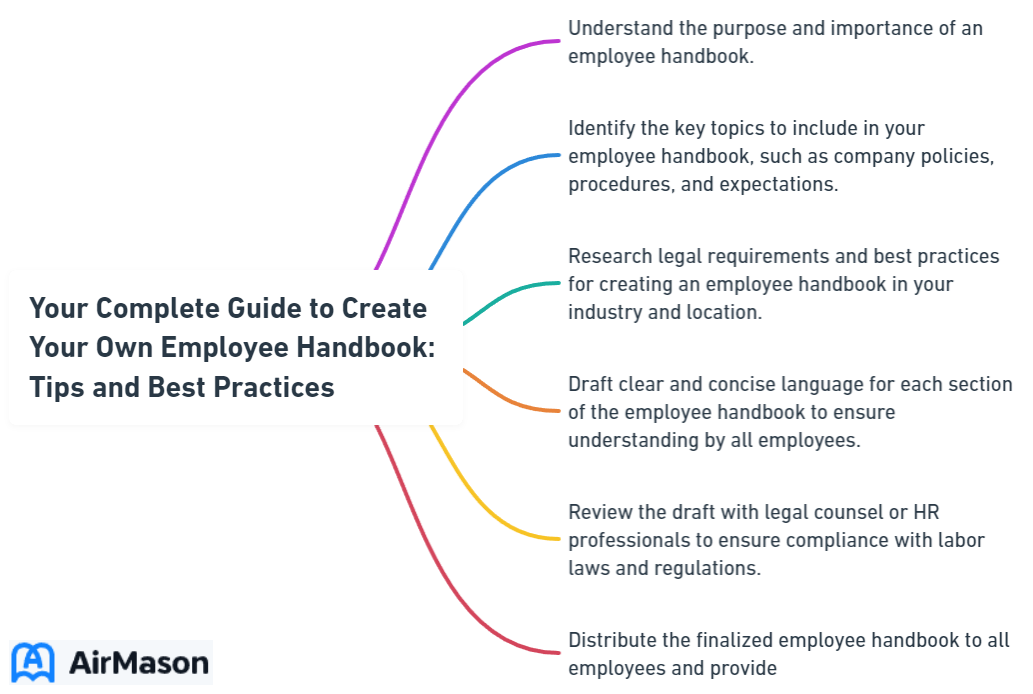
Creating your own employee handbook is fundamental for setting the stage for your company’s work environment and legal posture. This practical guide will outline the essential components and best practices to “create your own employee handbook”—and do it right. From defining your company culture and legal obligations to choosing appropriate policies, we ensure you have the know-how to build a handbook that aligns with your organization’s values and protects its interests.
Key Takeaways
- An employee handbook is a pivotal document that introduces company culture, outlines legal compliance, and defines clear workplace policies, contributing to a sense of community, preventative legal safeguards, and increased productivity.
- Effective handbooks should reflect the unique needs of the company and its industry, ensuring cultural alignment, legal accuracy, and the inclusion of industry-specific regulations, with continuous updates to adapt to legal changes and emerging workplace trends.
- Regular review and feedback mechanisms are essential for keeping the employee handbook relevant and up-to-date, including the need for clear communication and documentation regarding any amendments to maintain compliance and employee awareness.
The Importance of an Employee Handbook

A well-crafted employee handbook isn’t just a document; it’s a compass that guides employees through their professional journey within a company. It introduces company culture, fostering a sense of pride and belonging, leading to increased productivity among new hires. The handbook plays a crucial role in establishing a healthy work culture appreciated by employees by outlining the organization’s:
- history
- goals
- vision
- values
Moreover, the employee handbook serves as a protective shield for the business, outlining legal obligations and employee rights, providing a protective cover against potential legal claims. They ensure compliance with federal and state laws, conveying to employees their rights and what is expected of them.
A comprehensive handbook is more than just a set of rules; it’s a binding force that connects employees to their employers, fostering a strong sense of community and shared goals.
Customizing Your Employee Handbook
Creating a custom employee handbook for your small business isn’t a one-size-fits-all process. It requires careful thought and planning, keeping in mind the unique aspects of your company’s culture and vision.
Let’s delve deeper into the process.

Company Culture and Vision
A culture-first employee handbook, or culture book, makes a significant impact on the company’s reputation by communicating what the company stands for and attracting employees aligned with its vision. To ensure a culture book truly reflects the company’s unique corporate identity and inspires employees, it should include the company’s culture through:
- The company’s origin story
- Company values
- Core principles
- Company goals
- A definition of success
However, creating a culture book isn’t a one-and-done process. Consistency and clarity in the handbook’s tone, policies, and style are crucial for readability and effectively communicating the company culture and values in a cohesive manner. While sections on company culture within employee handbooks are usually brief, they need to be given appropriate priority to support the detailed descriptions found in a dedicated culture book.
Legal Compliance

An employee handbook isn’t simply a document of policies; it’s a legal anchor that keeps your company safely secured within the boundaries of federal, state, and local laws. This involves understanding and applying relevant laws to company policies, including those related to labor regulations, workplace safety, and anti-discrimination. Utilizing an employee handbook template can help ensure that you cover all necessary legal aspects in your own handbook.
It’s crucial to keep your handbook up-to-date with changing applicable laws to ensure continued compliance, with attention to aligning policies with local laws for businesses with employees in multiple states. Regular consultations with legal experts are advised to ensure continuous compliance and to safeguard against potential legal issues arising from policy contradictions or gaps between written policies and actual workplace practices.
It’s also essential to document all policies and procedures accurately, including any changes, to demonstrate compliance in case of disputes or audits.
Industry-Specific Considerations
Creating an employee handbook goes beyond company culture and legal compliance; it should reflect the unique legal and operational needs of the industry in which your company operates. This could mean adhering to healthcare privacy regulations for medical organizations or compliance with safety standards for construction companies. Regular dialogue and consultation with industry experts and legal professionals are necessary to stay up-to-date with the latest changes and updates to industry-specific laws and regulations.
For industries with unique skill requirements, high turnover, or certification mandates, an employee handbook should provide clear guidance on:
- Recruitment and retention strategies by hr professionals
- Training programs
- Career advancement opportunities
- Support for ongoing professional development
Employee Manual
The Employee Manual serves as a comprehensive guide outlining the expectations, policies, and procedures that govern the working relationship between employees and the organization. Within the Employee Manual, employees will find valuable information regarding their rights, responsibilities, and the company’s code of conduct. This document covers various aspects such as workplace behavior, leave policies, safety protocols, and disciplinary procedures. It is essential for all employees to familiarize themselves with the contents of the Employee Manual to ensure compliance with company policies and regulations. Additionally, the Employee Manual may be updated periodically to reflect changes in laws, company policies, or industry standards, and employees are expected to stay informed about any revisions. By adhering to the guidelines outlined in the Employee Manual, both employees and the organization can cultivate a productive and harmonious work environment.
Essential Policies for Your Employee Handbook

Establishing essential policies in your employee handbook lays the groundwork for a smooth, lawful, and harmonious employment relationship. At-will employment, if applicable, should be clearly stated, underlining that the handbook is not an employment contract. A firm stance against harassment and discrimination, including an anti harassment policy, should be noted in compliance with federal, state, and local laws.
In addition, comprehensive workplace safety policies contribute to a productive environment. These should include:
- The organization of health and safety issues
- Ongoing risk management
- Procedure for emergencies like fire drills
- PPE usage
- First-aid guidance
- A no-tolerance policy for unsafe behavior
A clear code of conduct and conflict of interest policy with a transparent process ensures orderly operations and mitigates legal issues while aligning with the company’s mission and ethical guidelines.
Additional Policies to Consider

With the basics in place, it’s time to consider additional policies that cater to the evolving workplace dynamics. A comprehensive remote work policy should include the following:
- Specify the terms for both permanent and temporary remote work setups
- Define a well-equipped workspace
- Detail communication protocols
- Outline employee responsibilities with company property
Having these policies in place is essential in today’s work-from-anywhere culture.
Moreover, in a world that’s becoming increasingly conscious about personal expression and individuality, dress code policies must communicate the standard of hygiene and grooming required, the necessity for workplace-appropriate attire without offensive content, and provide precise descriptions of what is expected for various dress code classifications like formal, business casual, or casual. The policy should account for different dress code requirements across departments or job functions and must be mindful to avoid discrimination and provide for religious accommodations if applicable.
Compensation, Benefits, and Perks
Clear communication about compensation, benefits, and perks in your employee handbook can help manage employees’ expectations and build a culture of transparency. A compensation policy that defines salary ranges based on experience, education, and performance and outlines different types of bonuses along with their eligibility criteria is a must.
The employee handbook should also list and explain employee benefits including:
- Vacations
- 401(k)
- Health insurance
- Paid parental leave
The handbook should state the eligibility, coverage scope, procedures for use, contributions, and handling during leave or termination procedures. Payroll deductions, including taxes and voluntary deductions for benefits, should be itemized, and details should be provided about the availability and process for changes to direct deposit information.
Information on medical insurance, life insurance, and other options like FSAs and HSAs, along with employee assistance programs to support personal issue resolution, should also be included.
Time Off and Leave Policies

Time off and leave policies are another crucial component of your employee handbook. The time off policy should distinguish between various types such as paid time off, sick leave, and parental leave, with clear definitions for each. PTO accrues at rates specified for different categories of employees and can be used without specifying a reason, with requirements for advance notice and encouragement to use PTO throughout the year.
The policy should include the following:
- Eligibility criteria for paid time off
- Outline of carryover or payout of unused benefits
- Provisions for converting vacation time to sick leave under certain conditions
- Parental leave policies to comply with state-specific legal requirements
- Availability of unpaid leave if PTO is exhausted (excluding legally or company-mandated leaves like sick or parental leave)
SHRM Employee Handbook Template
When it comes to creating a comprehensive and compliant employee handbook, utilizing a SHRM employee handbook template can be a prudent approach. SHRM, the Society for Human Resource Management, offers a variety of templates designed to streamline the process of developing company policies and procedures. These templates are crafted by HR experts and align with current employment laws and best practices. By starting with a SHRM employee handbook template, businesses can save time and ensure that their handbook covers essential topics such as employment policies, workplace behavior, benefits, and more. Additionally, using a reputable template can help organizations maintain consistency and professionalism throughout their employee documentation.
Performance Management and Disciplinary Process
Having a clear framework for performance management and disciplinary process is crucial. Establishing a fair disciplinary process in the handbook ensures employees understand the consequences of not following policies and promotes fair treatment and consistency in employee conduct. Disciplinary actions typically involve a gradual process, possibly starting with informal resolution up to and including dismissal for gross misconduct, with a thorough investigation and opportunity for the employee to respond.
The handbook should also outline clear performance evaluation criteria and processes for regular reviews and feedback, ensuring transparent and consistent management of performance. Termination and severance policies, including notice periods and severance pay calculations, should be detailed to inform employees about the end of employment processes and related benefits. Promotion and advancement policies should be clearly defined in the handbook to provide equitable career development pathways for all employees. The handbook should inform employees about eligibility for unemployment benefits upon termination and the company’s stance in the event of policy violations.
Employee Onboarding and Handbook Distribution
Congratulations! You’ve crafted an excellent employee handbook. But your job isn’t over yet. The handbook needs to be effectively distributed to your employees. Here are some steps to follow:
- New employees should receive a copy of the employee handbook as part of their orientation process.
- For existing employees, hold a meeting to introduce the handbook and ensure everyone is familiar with its contents.
- It’s essential to have a record of signed acknowledgments of receipt, review, and understanding from employees.
Remember, a disclaimer in the handbook stating that it is not a contract and is subject to change is advised for clarity and compliance. Distributing handbook addendums for updates is not recommended due to potential confusion; providing a completely new handbook is more straightforward, and training managers on new policies ensures consistent enforcement.
It’s also crucial to communicate updates to the handbook to all employees, including using electronic distribution to highlight the revisions and maintaining older versions for the applicable limitations period.
Collecting Feedback and Updating Your Handbook
An employee handbook is a living document. It should be regularly updated to reflect the evolving needs of the employees and the organization. Leverage online legal research tools like LexisNexis or Westlaw to keep the employee handbook in compliance with relevant laws, and engage with experts in regulatory compliance or in-house counsel for ongoing legal advice. Utilizing employee handbook templates can be a helpful starting point in creating or updating your handbook.
In addition to legal updates, it’s essential to gather insights using varied feedback tools such as:
- surveys
- employee engagement sessions including Town Halls
- exit interviews
- encouraging managers to discuss handbook content to understand employee sentiment
Schedule at least yearly or biannual reviews of the handbook to ensure it remains current, compliant with legal standards, and relevant to organizational changes.
Summary
After journeying through the intricate process of creating an employee handbook, we’ve realized the importance of crafting a comprehensive, custom, and compliant handbook. Whether it’s instilling a sense of belonging, promoting clear communication, or legally protecting businesses, a well-crafted employee handbook plays an integral role. Remember, the key to a successful handbook is regular updates and continuous feedback. So, let’s embark on this journey of creating a handbook that resonates with our employees and reflects our core values and principles.
Frequently Asked Questions
What is legally required in an employee handbook?
Employee handbooks are not legally required, but state and federal laws mandate the provision of specific information to employees, such as PTO, sick leave policies, and workplace rights. Always ensure compliance with these requirements.
How do I create an employee handbook in Word?
You can create an employee handbook in Word by opening the program, selecting “New” to create a new document, and choosing a template that matches your handbook’s style and purpose. Then, set up the page layout using the “Layout” tab.
What program do you use to make a handbook?
To create a handbook, you can use professional booklet publishing software like Adobe InDesign, Illustrator, Photoshop, or QuarkXPress. These tools are ideal for drafting original booklet designs.
Why is it important to have a custom employee handbook?
Having a custom employee handbook is important because it ensures that the policies and procedures are tailored to the company’s culture and legal requirements, fostering a strong sense of community and shared goals among employees.
How frequently should the employee handbook be updated?
The employee handbook should be reviewed at least once a year to ensure it remains current and compliant with legal standards and organizational changes.
Disclaimer:
Please be aware that the content on this page has been generated by using artificial intelligence language models and may contain errors, inconsistencies, or outdated information.
It is provided as-is without any warranties or guarantees of accuracy. We strongly recommend using this content as a starting point for further research. We disclaim any liability for damages or losses resulting from the use or reliance on this content.